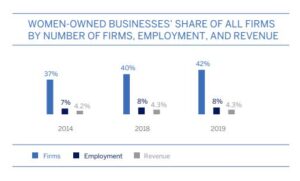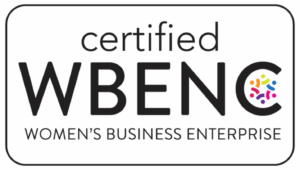We’re seeing more women-owned businesses, more female investors, and—what’s perhaps even more important—more brands waving their “women-owned and operated” flag, like a badge of honor. And we love to see it!
 As of 2019, according to the annual State of Women-Owned Businesses Report commissioned by American Express, there were nearly 13 million women-owned businesses in the U.S. The report also states that women-owned businesses generated $1.9 trillion in revenue for the U.S. economy in 2019. The growth rate of the number of women-owned companies was 3.9% annually, between 2014 and 2019, increasing 21% total. This rate is twice the rate for all businesses. Women-owned businesses only represented 4.6% of all businesses, in 1972 and in 2019 they represented 42% of all U.S. businesses, employing 9.4 million workers.
As of 2019, according to the annual State of Women-Owned Businesses Report commissioned by American Express, there were nearly 13 million women-owned businesses in the U.S. The report also states that women-owned businesses generated $1.9 trillion in revenue for the U.S. economy in 2019. The growth rate of the number of women-owned companies was 3.9% annually, between 2014 and 2019, increasing 21% total. This rate is twice the rate for all businesses. Women-owned businesses only represented 4.6% of all businesses, in 1972 and in 2019 they represented 42% of all U.S. businesses, employing 9.4 million workers.
In the same span of time, the number of businesses owned by women of color increased by 43%, doubling the growth rate of women-owned businesses (21%). As of 2019, women of color made up 50% of all women-owned businesses and generated 23% of total women-owned businesses’ revenue, according to the annual State of Women-Owned Businesses Report commissioned by American Express.
Challenges
Not too different from the challenges of the past, today women-owned businesses are struggling with: access to capital, childcare responsibilities, and the subtle societal prejudice against women entrepreneurs. According to the 2020 report from National Women’s Business Council (NWB), more than 57% of microloans are going to women entrepreneurs, but female founders received only 2.2% of venture capital dollars in 2018.

Growth in funding for women entrepreneurs has not kept pace with the growth of other types of support. While 79% of U.S. women-entrepreneurs feel more empowered now, than they did five years ago, 66% still report difficulty obtaining the funding they need to succeed. What this troubling statistic means is that while women may feel that they have other resources to support their entrepreneurial journey, they’re still not receiving the financial support from investors or VCs needed to get their venture off the ground. According to the 2019 Columbia Business School study, female-led firms are 63% less likely to receive VC funding.
“Finally, women business owners are less likely to seek business loans than male business owners. While just a quarter of women business owners seek business financing, a third of male business owners seek business financing. Though this women in business statistic might paint a picture of tighter budgeting, it could also explain why women-owned businesses contributed to just 4.3% of total private sector annual revenue. If more women business owners seek and gain access to business financing for growth opportunities, perhaps their contribution to US revenue will become more proportional.”
Industry Specific
Female food entrepreneurs are on an upward trajectory. Building businesses, raising money, and curating initiatives and organizations to combat the industry boy’s club, and they’re making incredible meals, beverages, and CPG products while they do it.
According to the NRA (National restaurant Association) more than half of the restaurants in the US have women as full owners or co-owners, with women as about 45% of restaurant managers, which is higher than the 38% of female managers in other industries. Women are simply more likely to hold mid to senior leadership roles in the restaurant industry than other industries.

Over 60% of women have worked in the U.S. restaurant industry at some point in their life, but who manages them can make all the difference in their experience and success overall. Without female leadership, the restaurant’s work culture for females is often described as strained, or even toxic at its worst. The need for gender equity in the workforce on all levels is key to ensuring women have the best opportunity for success.
Many female leaders aim to create work environments they wanted to see when they started out. Little by little, female chefs, managers, and owners are helping change the industry’s perceptions of women from the inside out.
Economy Effected
Undoubtedly, women-owned businesses are driving economic growth in the United States. Again, women-owned represents 42% of all businesses (nearly 13 million), employing 9.4 million workers and generating revenue of $1.9 trillion. Yet significant size disparity exists between these businesses and others. Closing the gap benefits everyone, not just women. More goods and services bought and sold grows the economy.
As women and minorities have a combined buying power of around $10 trillion dollars, or about 66% of total US buying power. When women are given the keys to create something great, we know they reward their communities with re-investment. Buying female truly is buying local.
“Realizing the economic potential of women-owned businesses requires changes in policies, business practices and attitudes. Some changes, such as family leave and affordable childcare, impact all working women while others, such as training and access to capital and markets, are specific to particular segments of business owners. Making meaningful change also requires understanding that women-owned businesses are not monolithic. Factors such as gender, race, ethnicity, entrepreneurial motivation, generation and geographic location make meeting their needs more complex.”
Our Story

As a certified women-owned business, we believe in the advancement of women. More than a third of our management positions are held by women, and 60% of our supervisors have been promoted from within the company. We foster a collaborative environment of cultural vibrancy and inclusion, reflective of our beloved city; learning from different experiences and embracing each other’s strengths.
“Women, in particular, have a natural tendency towards inclusiveness. We champion big goals early on and drive the mission, because we get it. Women have a passion, they create believers. And that energy makes it flow throughout to their teams and to the company. When it comes to long-term goals, there’s a steadiness there, at the same time as, they get the big idea, it’s an awesome combination. Women are collaborative, they think and plan as a team. They bring these certain skills, inclusiveness and their ability to communicate well, and when they’re smart, we’re unstoppable.” – Sandy Solmon, Founder and CEO of Sweet Street Desserts
We reinvest in our community by championing economic development and access to the arts and education. Sweet Street is involved in Downtown Reading Revitalization by joining Reading CollegeTown, The GoggleWorks, and Jazz Fest. This not only beautifies downtown and expands the communal space, but enriches the lives of our community and creates a lasting impact.
We are passionate about buying local when possible, and being corporately responsible. We’ve initiated sustainability programs with suppliers, supporting women farmers via the Honduras Cocoa collective, facility wide recycling program. All of which ensure our community can flourish for future generations. Investing in women-owned businesses truly is buying local.
COVID-19
It’s no surprise that all businesses were affected during the pandemic. However, the impact was felt more strongly by some. “Women, particularly working mothers and Black moms especially, have taken the brunt of national job loss due to the COVID-19 pandemic. Raising a family and juggling work responsibilities was challenging before schools closed and day cares limited capacity; tacking on the complexities of the past year only made it harder.”
The NWBC’s report said that the number of women-owned businesses fell by 25% from February to April 2020. Of the over 1.1 million workers, age 20 or older who dropped out of the labor force in September 2020, 80% of them were women.
Diversity in all its many forms drives innovation. Women have different perspectives, skills and experiences and therefore solve problems in new and innovative ways. As it turns out, women are often more likely than business owners in general, to see a need in the market and build a company to fulfill it. This bodes well for the U.S. economy, but women face more obstacles when starting and growing their businesses, than entrepreneurs in general. Eliminating barriers that hinder the success of women-owned businesses is an economic necessity that will stimulate innovation and improve productivity, which will create jobs, build wealth and grow the economy.
Resources:
Chicago Tribune | Great Business Schools | Big Ideas | Forbes | State of Women-Owned Report | Small Biz Trends | Foodboro | Try Cake | Fundera | Rewards Network


Leave a Reply